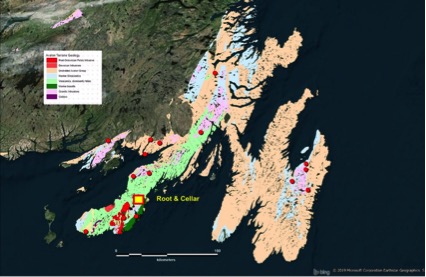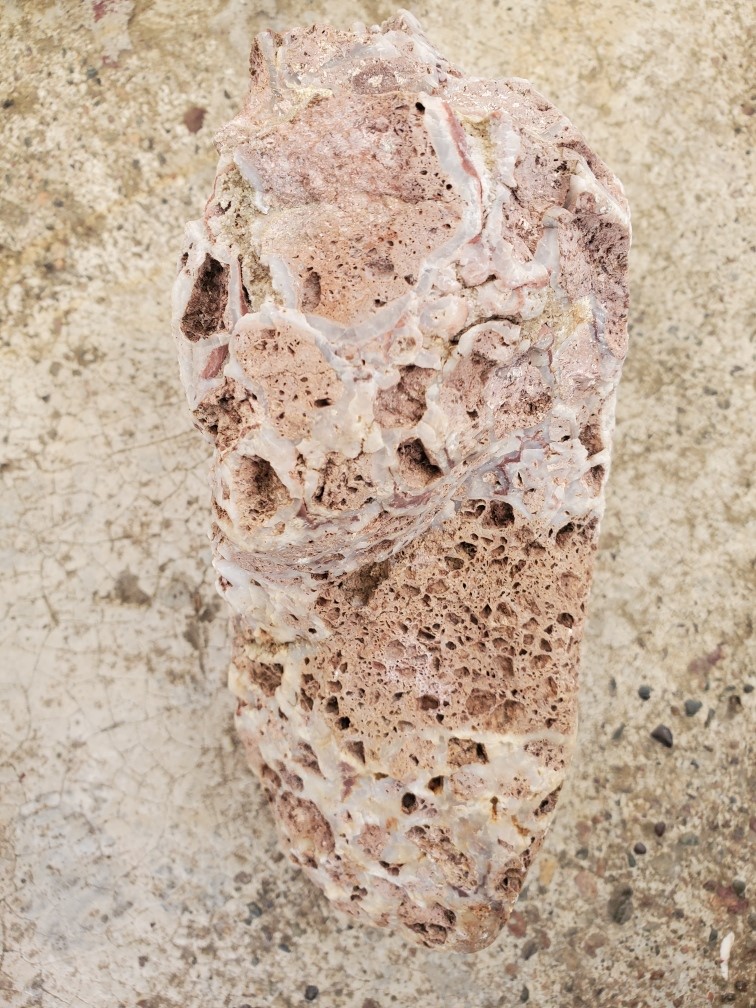ROOT & CELLAR (Au-Ag, Cu), Newfoundland
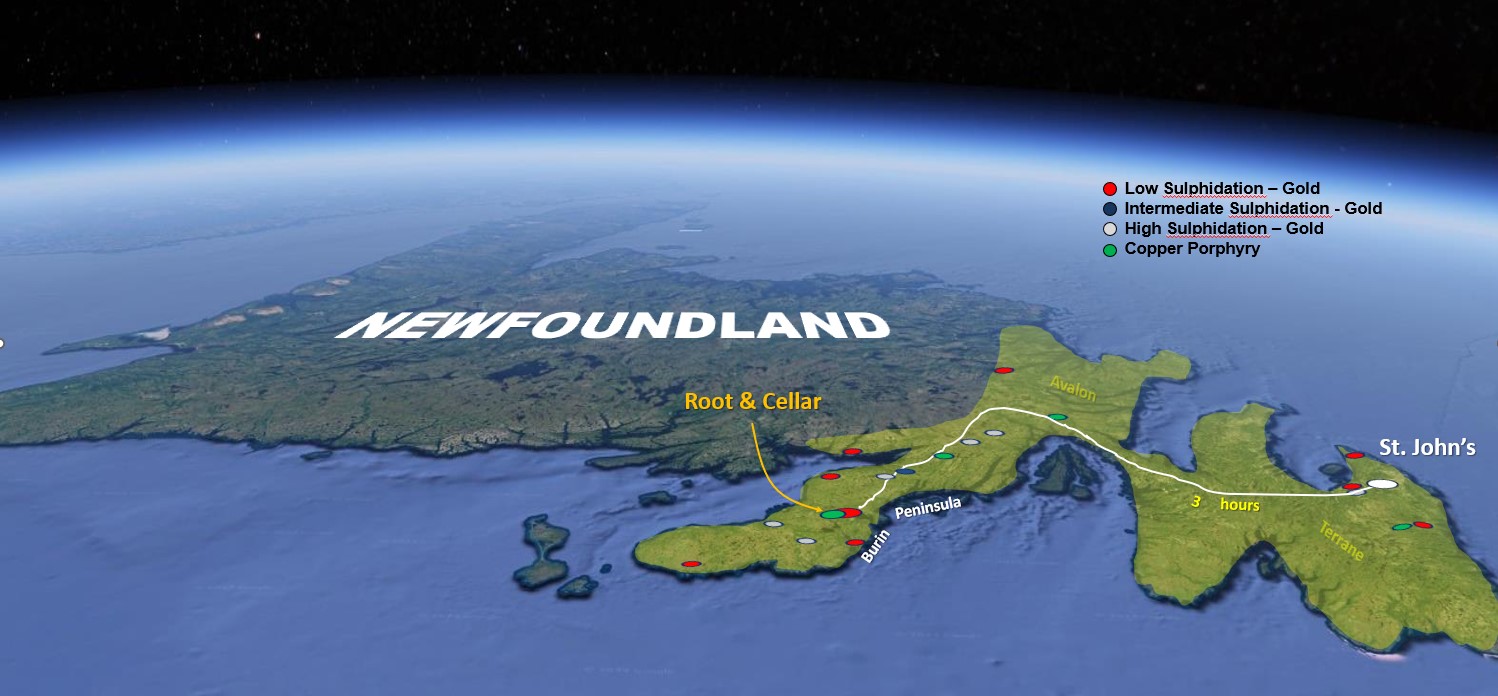
Northern Shield owns a 100% interest in Root & Cellar property located near Marystown and Creston on the Burin Peninsula of Newfoundland, a three-hour drive from St. John’s.
The Property sits within the Avalon Geological Terrane and is primarily being explored for epithermal-type gold-silver mineralization though there are also strong indications and potential for porphyry copper. Porphyry copper and epithermal gold deposits are end members of the same hydrothermal system and so can be found in the same geological setting.
The Avalon Terrane in Newfoundland hosts a growing number of epithermal gold, and related copper porphyry occurrences over a 200 km long belt all of which are relatively new discoveries (mid 1980s to 2015). Its is similar to the Carolina and Nevada gold/copper belts that have been explored for a better part of a century. In comparison, the Burin is vastly under explored.

Low sulphidation epithermal gold systems are renown for their bonanza grades of gold and silver but typically associated with relatively small tonnages. With grab samples up to 111 g/t gold, 1,395 g/t silver and 700 ppm tellurium at Root & Cellar, the high grades are apparent.
However, a select few of low sulphidation gold deposits are also associated with very large tonnages. A comprehensive exploration model and multiple datasets suggests that Root & Cellar has all the ingredients to form one of those few giant and high-grade epithermal gold systems.
While the Company has focussed on advancing the gold-silver-tellurium zones the copper porphyry potential is also very real. Why do we say this? Well, firstly the western portion of the property hosts numerous samples anomalous in copper, in a porphyry-type setting with grades up to 10.5% copper. Secondly, because it was previously assumed that because the Appalachians represent the eroded roots of a what once was an “Andean” like volcano/mountain belt, that the copper porphyries were also eroded. But copper porphyries form below epithermal gold systems and as we are now finding a large and intact epithermal gold systems at Root & Cellar, it means the copper porphyries are also preserved.
Epithermal Gold
 “Epithermal” gold deposits are a type of gold deposit that form relatively near to the surface at the time that the deposit formed. The hydrothermal fluids often breach surface and are manifest as geysers and hot springs. (Think Yellowstone).
“Epithermal” gold deposits are a type of gold deposit that form relatively near to the surface at the time that the deposit formed. The hydrothermal fluids often breach surface and are manifest as geysers and hot springs. (Think Yellowstone).
These fluids carry silicaand the accumulation of silica form sinter mounds of flat lying terraces. The upper part of the veins that lie immediately beneath the sinter contain certain pathfinder elements such as arsenic, antimony and mercury, but typically do not contain much gold. The gold is precipitated in boiling windows that may be a few tens to hundreds of meters deeper. Gold deposition in epithermal veins is brought about when the rising hot fluid boils.
Epithermal deposits are sub-divided in low, intermediate and high sulphidation. Low sulphidation deposits are renown for their bonanza grades of gold and silver. Epithermal gold systems are related to copper porphyries. High sulphidation deposits form hundreds to a few thousands of meters above the copper with low sulphidation deposits forming higher still and further away laterally.

Epithermal gold veins are often characterised by beautifully banded quartz veins known as crustiform and colloform banding.
Tellurium
Tellurium is a critical metal. It is one of the rarest elements on the planet and 8x more rare than gold
Its primary source is as a by-product of a handful of epithermal gold, silver and related copper deposits. Its main use is in:
- Solar panels
- Semi-conductors
- High efficiency Li-Te batteries* (experimental stage)

Project and Exploration Summary
Gold, silver and copper mineralization was first discovered at Root & Cellar (or the “Property”) by Mr Brushett in 2012. Northern Shield is the first junior mining company to conduct systematic exploration on the property.
The property hosts 5 epithermal gold-silver +/- tellurium occurrences over a large area that appear to over overprint a pre-existing copper porphyry-type system. Alteration, textures and mineralogy are generally indicative of a low sulphidation epithermal systems but characteristics suggestive of intermediate to high sulphidation and even mesothermal gold systems are locally present. These are important features on their own as such fluctuations in hydrothermal temperature conditions are often evident in large and high-grade epithermal systems (e.g., Brucejack).

Three of the showings, Drop Zone, Windfall and Braxton-Bradley exhibit very high silver to gold ratios and often associated with high to very high tellurium content. The Conquest Zone, in the centre of the property has the largest foot-print of gold mineralization of all the zones and is characterized by lower silver to gold ratios.
All the gold mineralization is located on the periphery to a large copper-bearing zone in the western portion of the property. The copper mineralization dominantly consisting of chalcopyrite, bornite, and chalcocite is predominantly found in a series of felsic phreatomagmatic and vent breccias and other “fragmentals.
Conquest Zone
The Conquest Zone, which has been the focus of exploration to date has all the ingredients to form a giant and high-grade epithermal gold system.
Surface and drill sampling along with till sampling has identified gold mineralization and anomalism over an area measuring approximately 2 sq km. Much of the mineralization and better grades are found in southern Conquest Zone along an east-west trend that includes the original discovery trench.
The maiden drill program on the property in 2021 largely targeted near surface IP chargeability anomalies in the Conquest Zone that also trended east-west which was consistent with lithological contacts and structures observed on surface. The drill program was of limited success with only three of eight drill-holes in southern Conquest hitting modest grades of near surface mineralization with a high of 1.4 g/t Au over 7.95 meters including 5.7 g/t Au over 1 metre. Drill-holes targeting the same zone at depth were not successful in intersecting mineralization.
Further modeling of the IP indicated that the E-W trending IP anomalies had limited depth extent, but multiple north-south trending IP chargeability anomalies were apparent at depth. None of the 2021 drill-holes interested these anomalies.
Fieldwork in 2024 concluded that some of the mineralization in the Conquest Zone, including that targeted in the 2021 drill program, is formed from lateral flow of hydrothermal fluids (from an up-flow zone) and from general leakage of mineralizing fluids from depth along contacts and structures. Such mineralization is manifest as very dark grey to black siliceous breccias with abundant fine-grained marcasite. Despite their unusual dark colour, these rocks are highly elevated in potassium (up to 6-7% K2O).
Mechanical trenching of the original hand-dug discovery trench in 2023 resulted in visible gold being identified in eight grab samples with up to 20 fine-grained flecks of gold noted under the microscope from a single sample. The visible gold was largely hosted in quartz-adularia veins where northerly trending fractures crosscut the east-trending structure. Both structural orientations are associated with pyrite mineralization and quartz veining including classic colloform-crustiform banding indicative of low sulphidation epithermal systems. Fourteen of 28 grab and composite rock samples collected from this trenching and sampling program in the Conquest Zone, assayed between 2.0 and 26.0 g/t Au, including a grab rock sample from 30 metres to the west of the trench, which assayed 7.3 g/t Au. Additional prospecting of the Creston Copper Zone in 2023 returned three samples returning concentrations between 0.9 and 1.75% Cu with another containing 0.5% Mo (molybdenum) and 185 ppm Te, suggesting the presence of a porphyry-type system.
Based on the trenching results an eight-drill hole program, totalling 615 metres, was completed in the vicinity of the trenching in 2023. Seven of the eight drill holes intersected gold mineralization consistent with a low-sulphidation epithermal gold system. Five occurrences of visible gold were noted in drill holes 23RC-16, 18 and 21. Mineralized zones on drill holes 23RC-16,17,18 and 20 dominantly consist of complex quartz-illite-pyrite/marcasite hydrothermal breccias. Such breccias will typically form above or near the main up-flow zone and veins and are well documented from the Waihi epithermal gold deposit in New Zealand, for example. Drill-holes 23RC-21 and 22 also intersected breccias but of a different nature. Some of the breccias included fragments of what appears to be sinter.
DDH 23RC-21 - 10.4 g/t Au over 1.5 m including 23.5 g/t Au over 0.5 metres
DDH 23RC-21 - 3.1 g/t Au over 1 metre
DDH 23RC-18 - 5.7 g/t Au over 2 metres
DDH 23RC-16 - 0.6 g/t Au over 34.5 metres including 9.5 g/t over 0.65 metres
Sinter mounds would be expected to form above the up-flow zone. The outflow zone is supported by short intervals of geyser-like siliceous and muddy looking sedimentary rock which would also be expected to form near the outflow zone. The identification of the up-flow zone by textural features has been supported by geochemistry. On-going work by a student undertaking a M.Sc. thesis on Root & Cellar applied K/Al GER plots from a case study on the epithermal gold deposits at Waihi New Zealand to Root & Cellar and it worked remarkably well at highlighting this main up-flow zone. and also potentially doubling the strike-length of part of the Conquest Zone.
Up-flow zones represent where the epithermal fluids rising up through structures would have breached the surface that existed at the time of formation. The boiling zone where high grades of gold are expected would typically be a few tens to hundreds of metres below the outflow zone. In addition, the presence of visible gold in the outflow, where high grades are not expected bodes very well to what may be found in the boiling zone.
A sub-vertical IP chargeability anomaly coinciding with a magnetic low feature, underlies this up-flow zone. This is just one of several coincident IP-magnetic low targets in the Conquest Zone.
The Root & Cellar Au-Ag-Te prospect is characterized by a series of bimodal calc-alkaline flows, and related pyroclastic material. On the north end of the prospect is a steeply dipping, stratigraphically thick package of ignimbrite, ranging from tuffs to monomict tuff breccias. This package of rocks is identified across the northwestern and north central ridges. East of the Hodders pond fault, in the main Conquest zone, the structure and orientation of the rocks is enigmatic due to poor exposure and a large volume of massive flows resulting in minimal structural measurements. The geology is dominated by east-west trending basaltic flows with few outcroppings of rhyolite tuffs and fragmentals. Multiple small outcrops of a sub-vertically foliated rhyolitic lithic crystal tuff to tuff breccia are observed in the central Conquest Zone over a strike-length of about 600 metres. This unit might be correlated to intercepts in DDH10 with an estimated dip of ~80o south. Earlier interpretation of these suggest they could be vertically flow-banded rhyolite spines. Preliminary cross sections based on DDHs 17, 18, 20 in the southwestern Conquest Zone indicate the geology to be more shallowly dipping ~45o south and possibly show that dip is variable and difficult to constrain due to paleotopographic controls. South of the main ridgeline and west of the Hodders pond fault, the geology is characterized by outcropping of porphyritic rhyolite. Massive mafic flows separate the porphyritic rhyolite from felsic fragmental and associated flow banded rhyolites moving south towards the quarries.
On a property scale, the rocks are dominantly subjected to an early-phase of intense epidote-chlorite-carbonate alteration that is believed to represent the propylitic alteration zone of a copper porphyry. This is most intense in the Conquest Zone. This has been locally overprinted by progressive illite-sercite, silica and potassium alteration. The intensity of this second phase of alteration is a function of k-metasomatism, directly corresponding to increases in potassium concentration and decreases in sodium and calcium concentrations. The intensity of k-metasomatism also directly corresponds to common pathfinder element concentrations (e.g., As, Hg, Mo), and most notably, Au mineralization.
Coming Soon
Root and Cellar Images - October 17, 2023






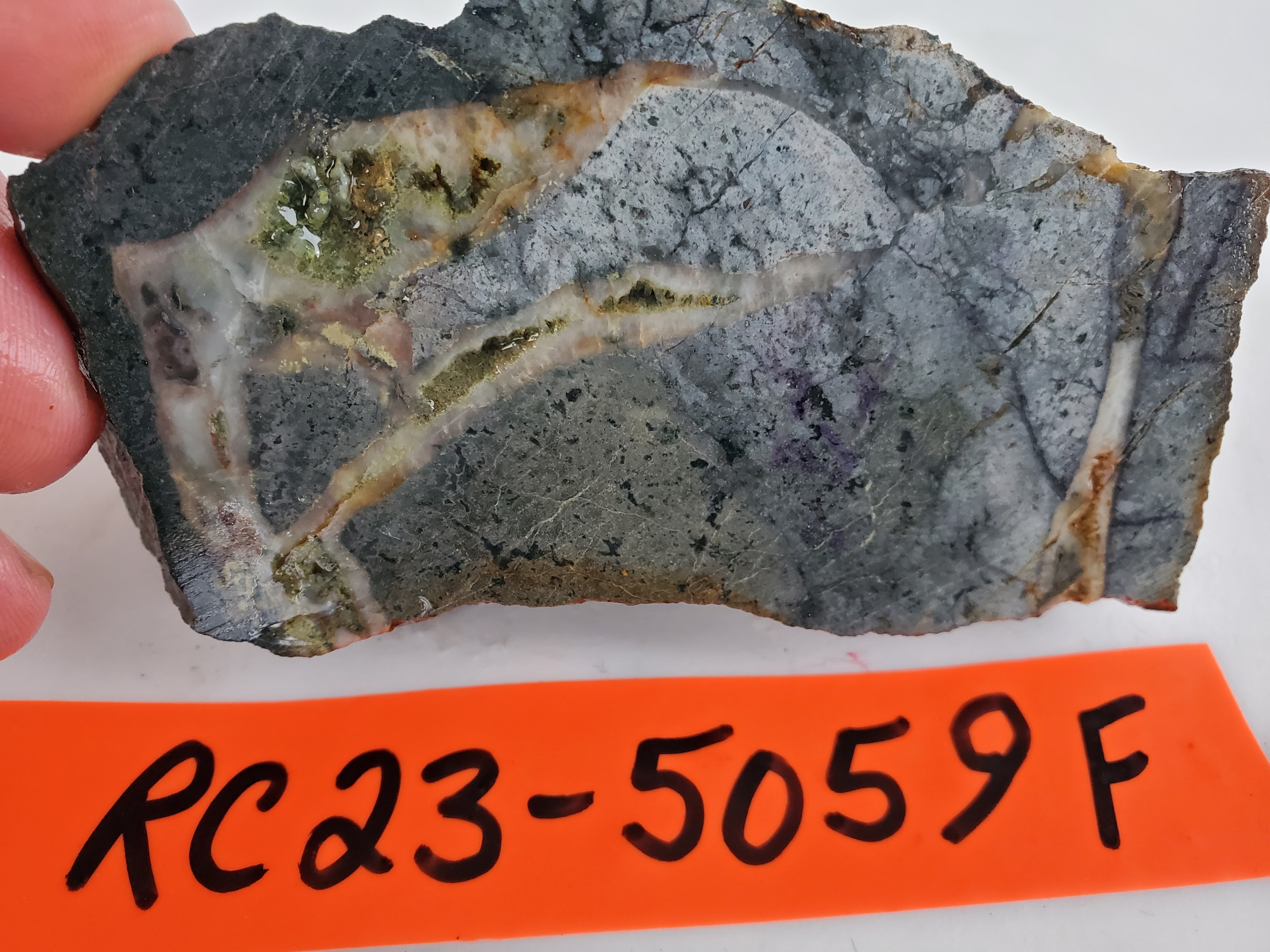
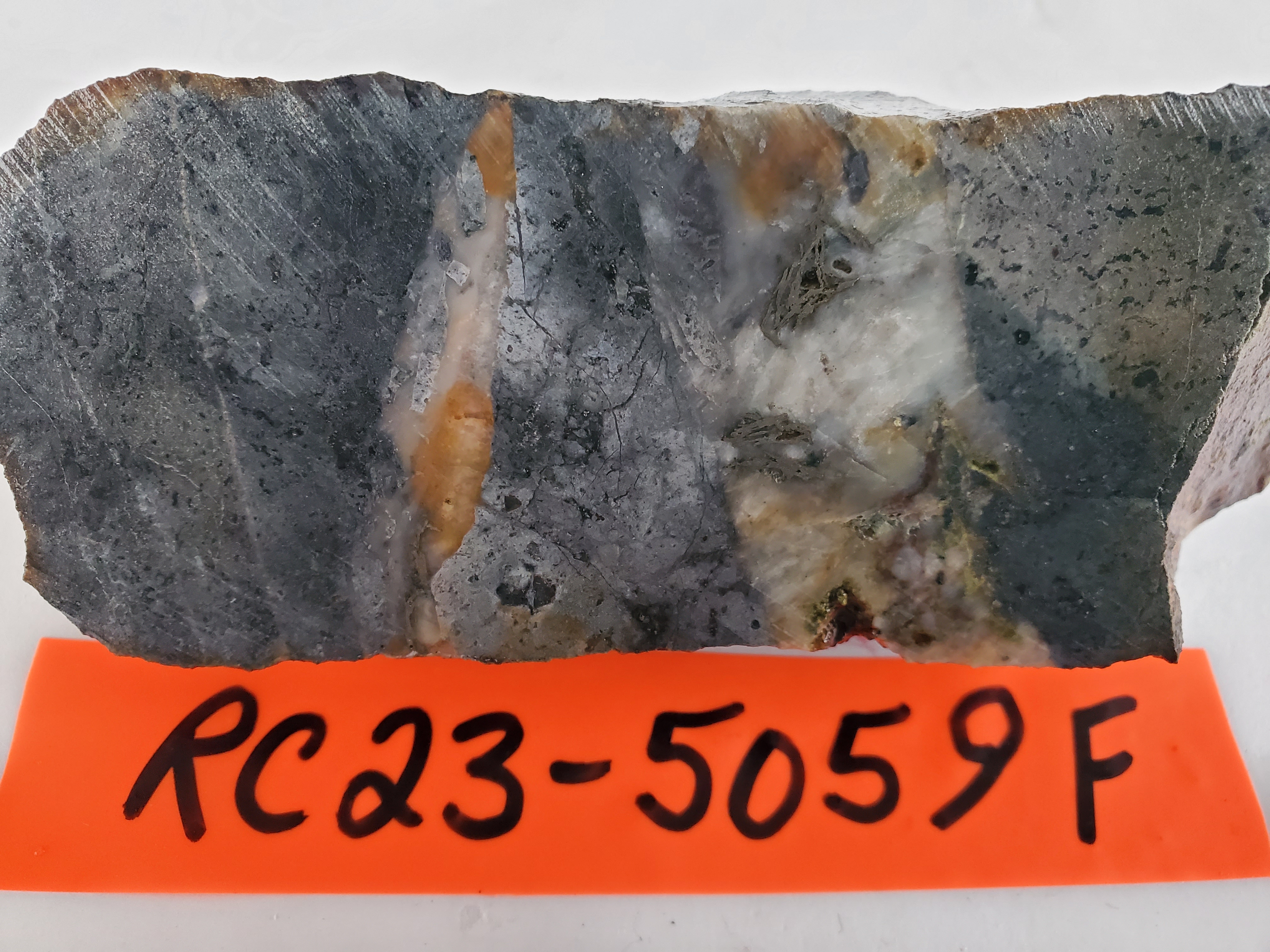






Visible Gold From 30 kilogram boulder form Root & Cellar. A sample from this boulder assayed 111.5 g/t Au. No visible gold was noted in the sample sent for analysis.
Completely silicified mafic volcanic rock containing disseminated sulphides that has subsequently hydrothermally brecciated. Note the ginguro-like rind to some of the fragments. That band contains fine, silvery-bue to greyis-black metallic particles.
Boulder found near the rhyolite dome at the western end of the Conquest Zone. Sample exhibits fragments of strongly acid leached volcanic rock brecciated and cut by chalcedonic quartz veins. Such rocks are indicative above epithermal systems.


